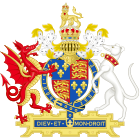Merchants of the Steelyard facts for kids
| Act of Parliament | |

|
|
| Long title | A Provysyon for the Marchauntes of the Stylyard in London. |
|---|---|
| Citation | 26 Hen. 8 c. 26 |
The Merchants of the Steelyard was the name given to a group of important traders. These merchants were part of the Hanseatic League, a powerful trading alliance in Europe. They first came to London in 1250.
They settled in a special area called the Steelyard, right by the River Thames. This area was near what is now Cannon Street station. Over time, the Steelyard grew into a large, walled community. It had its own warehouses, offices, and even a church. This shows how important their trading activities were. The name "Steelyard" (or der Stahlhof in German) was first used in 1422.
The land and buildings at the Steelyard belonged to the Hanseatic League. They rented out parts of it to other merchants for business. Sadly, the Steelyard was destroyed in the Great Fire of London in 1666. It was rebuilt as warehouses. Finally, in 1852, the Hanseatic towns of Lübeck, Bremen, and Hamburg sold the property to the South-Eastern Railway Company.
Contents
Who Were the Steelyard Merchants?
The Merchants of the Steelyard were a branch of the Hanseatic League. This league was a group of merchant guilds and market towns. They dominated trade in Northern Europe during the late Middle Ages and early modern period. The Steelyard served as their main trading post, or Kontor, in London.
Life at the Steelyard
The Steelyard was more than just a trading post. It was a self-contained community. Merchants lived and worked there. They had their own rules and customs, separate from the rest of London. This allowed them to manage their vast trading network efficiently.
Daily Trade Activities
Merchants at the Steelyard handled many goods. They imported things like timber, furs, and grain from Northern Europe. They exported English wool, cloth, and tin. The weighhouse was a key building. Here, goods were carefully weighed to ensure fair trade.
The Hanseatic League's Influence
The Hanseatic League was very powerful. It controlled much of the trade across the Baltic and North Seas. Their presence in London, through the Steelyard, had a big impact on England's economy. They helped connect England to wider European markets.
Challenges and Decline
Over time, the power of the Hanseatic League began to fade. Other trading groups and nations grew stronger. The English Crown also started to favor its own merchants more. This led to new laws and taxes that made it harder for the Steelyard merchants to do business.
The Act of 1534
The "Merchants of the Steelyard Act 1534" was one such law. It aimed to control foreign merchants in England. While the details of this specific act are complex, it was part of a larger trend. England wanted to boost its own trade and reduce the influence of foreign groups like the Hanseatic League.
End of an Era
The Great Fire of London in 1666 was a major blow. Although the Steelyard was rebuilt, its importance had already lessened. By the 19th century, the Hanseatic League's role in London trade was minimal. The sale of the property in 1852 marked the final end of the Steelyard as a Hanseatic trading center.

